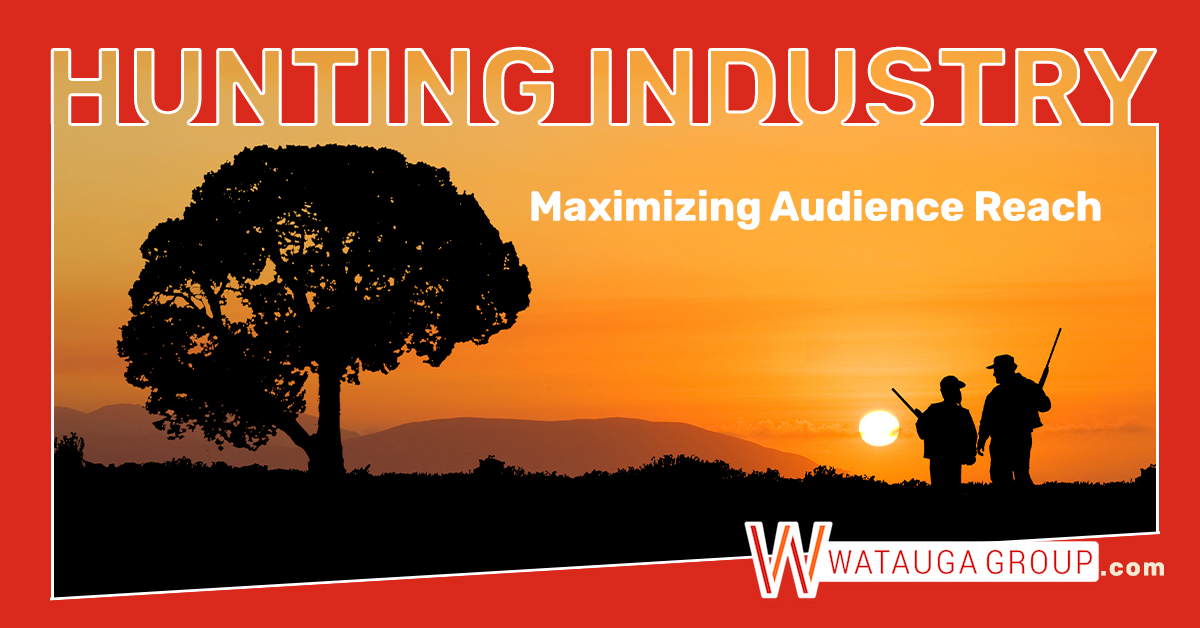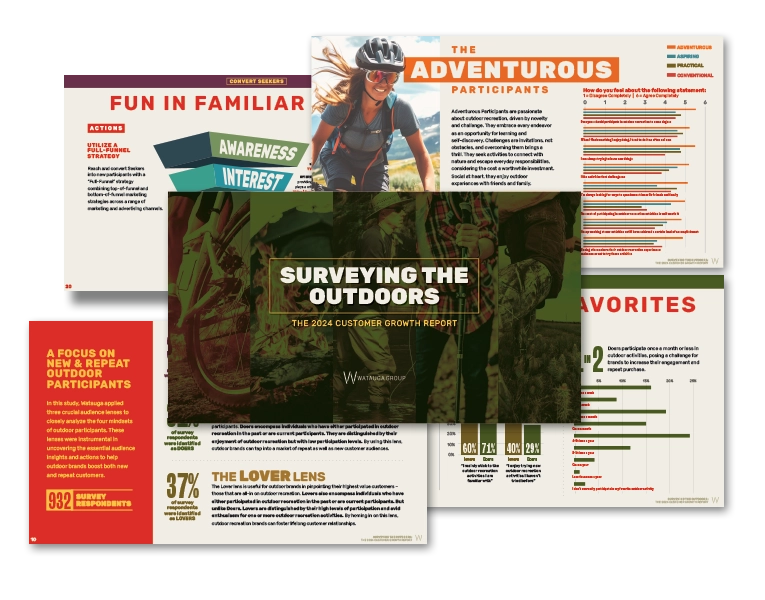With any marketing strategy, the better you know your target audience, the more successful you’ll be — you can improve conversions, increase engagement, and maximize return on advertising spend (ROAS). When it comes to the hunting industry, age is a defining audience characteristic. The old-timer who likes to hunt with his lodge buddies will communicate differently from the young hot-shot who loves to show off at the range. That means to reach both, your hunter advertising strategy has to shift as well.
Based on Watauga’s recent study on hunting industry consumers, hunters are evenly split between older and younger with 50% aged 18-44 and 50% over 45. This balanced split means to reach all potential customers, hunting companies can’t simply focus on just the old-timer or hot shot — they need to strategically blend both unique sets of people.
Here, experts Jenny Williams and Megan Dillon weigh in on the study’s key insights and offer guidance on how the findings should influence future hunting industry marketing plans.
Hunters of All Ages Love Sports
Because the hunting industry’s two unique target audiences have so many differences, finding the commonalities is essential.
“Chances are you don’t have double the budget to go build two totally separate media plans for your target audience,” says Jenny. “So you’ve got to figure out that sweet spot between the two segments to invest your dollars and your focus.”
The sweet spot for hunting marketing? Sports. Regardless of the sport, Watauga found that hunters have a general love for sports — watching live sports on TV, consuming sports news on air and online, live sporting events, fantasy sport teams, and participating.
Some of the data we found supporting this insight include:
- ESPN is within the top 3 networks in terms of weekly reach across both audiences.
- NFL, MLB, NCAA Football, and NCAA Basketball are the most watched show types.
- Compared to the general adult 18+ population, hunters are more likely to access sports apps.
- More than a quarter of hunters have attended a sports event in the last 12 months.
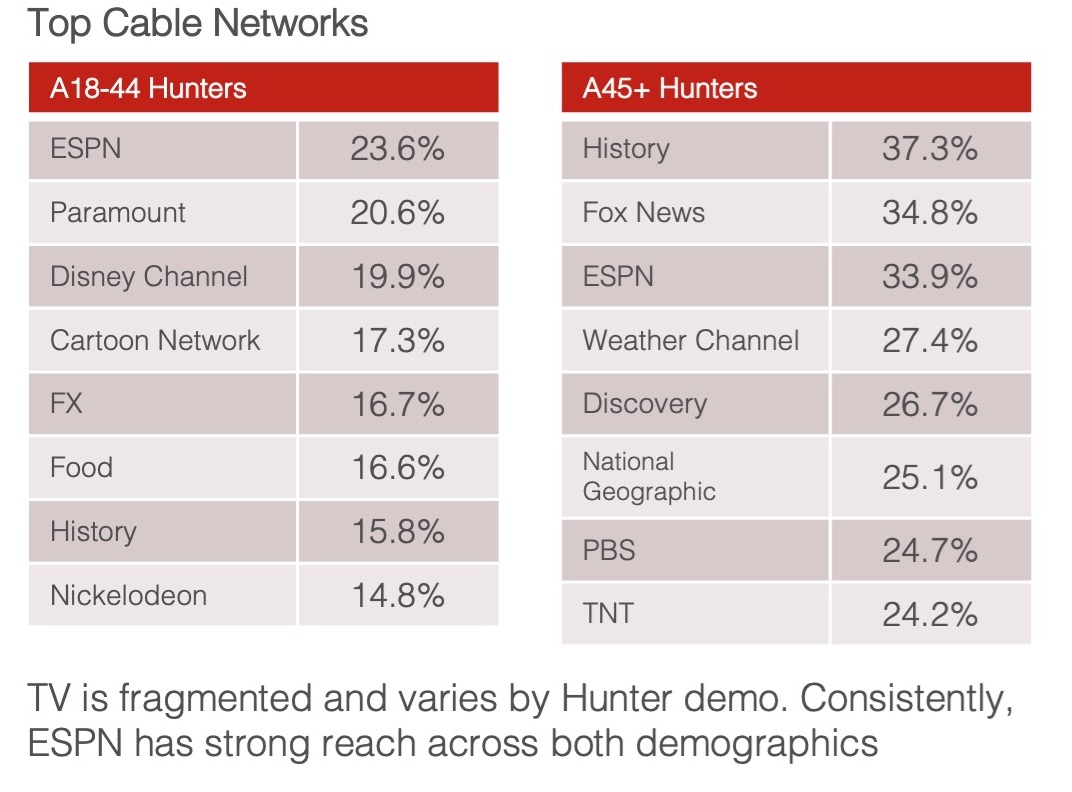
Delving into these opportunities within sport is where hunting marketing campaigns can get the most reach, outperform competitors, and tap into more of their target audience.
Sports is like the rut for hunting the hunting industry, if you will.
The exact details for implementation will (and should) alter for each demographic, but using sports as a focus makes the process more streamlined and cost-efficient.
Ways to Capitalize on Sports Media:
- Sponsoring sports tournaments, events, and leagues: You don’t need an NCAA exclusive sponsorship-level budget to find opportunities to partner or sponsor other sport events.
- Advertising in sports apps: With hunters being more likely to access them, sports apps are a valuable opportunity to expand hunter advertising tactics.
- Align with sports digitally: Instead of buying expensive TV spots in live sports or hunting & fishing programming, consider a digital alignment within sports clips, replays, analysis, etc. This allows hunting and fishing brands to reach their audience in white space away from competitors and at much lower costs.
Defining Where the Strategies Diverge
While both demographics have the connecting interest of sports, it’s essential to account for the differences as well. Because the audience split is literally 50-50 between younger and older, you don’t have one primary audience and both sections’ behaviors are equally important.
“If you’re building one general plan for all hunters, you’re missing one of the two audiences,” explains Jenny.
With this in mind, these are some of the key ways Watauga recommends altering your hunting marketing strategy for each demographic.
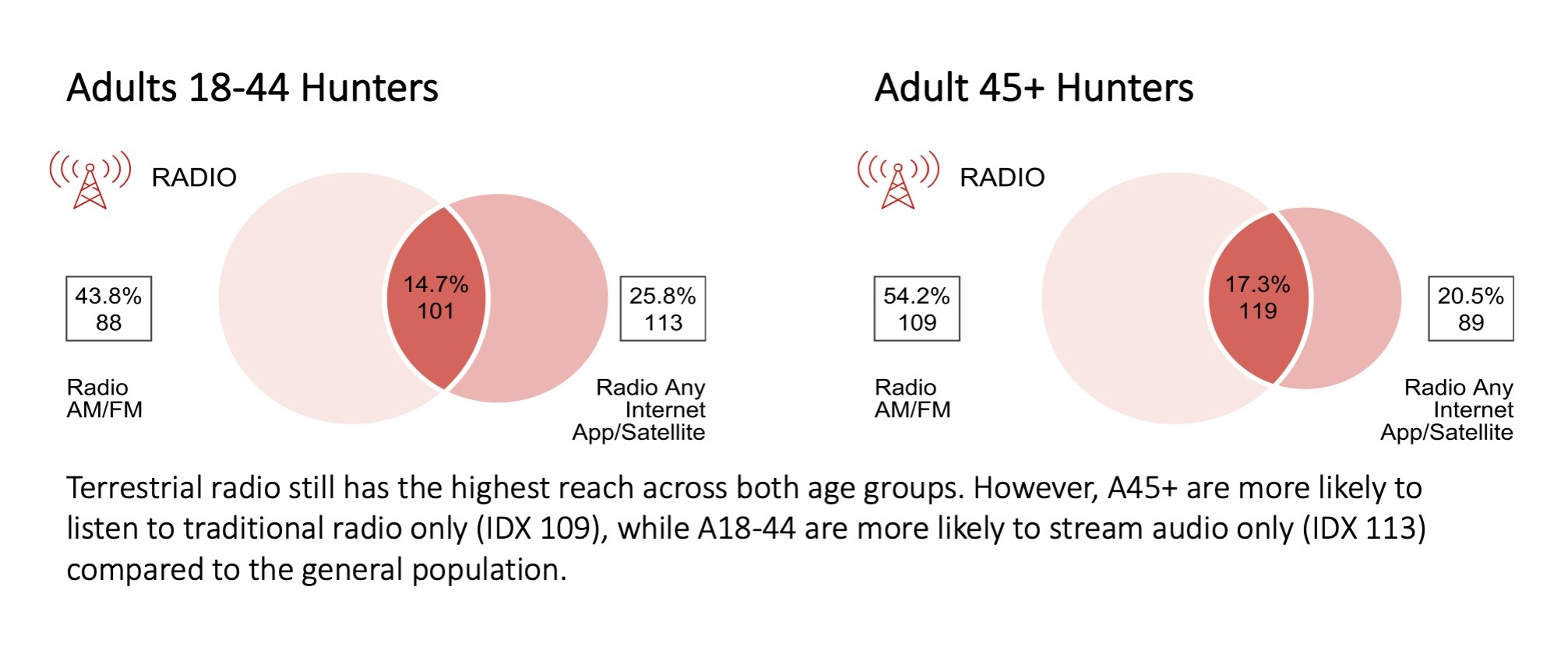
Overall, radio has a strong reach with 83% of all hunters listening to radio. This makes radio a key medium that can deliver cost-effective results for the hunting industry. However, the specific method of listening to radio differs between the younger and older demographics meaning your hunting marketing strategy has to be multidimensional as well.
82% of younger hunters stream audio whereas the older demo prefers traditional terrestrial radio and only 53% streams audio. Within streaming, the younger demo prefers Spotify with a reach of 43.9%, while older hunters skew to Pandora with a 23.3% reach.
“You could still focus on similar programming, but you’d buy in a way that delivers through both streaming and terrestrial to account for both audiences,” says Jenny.
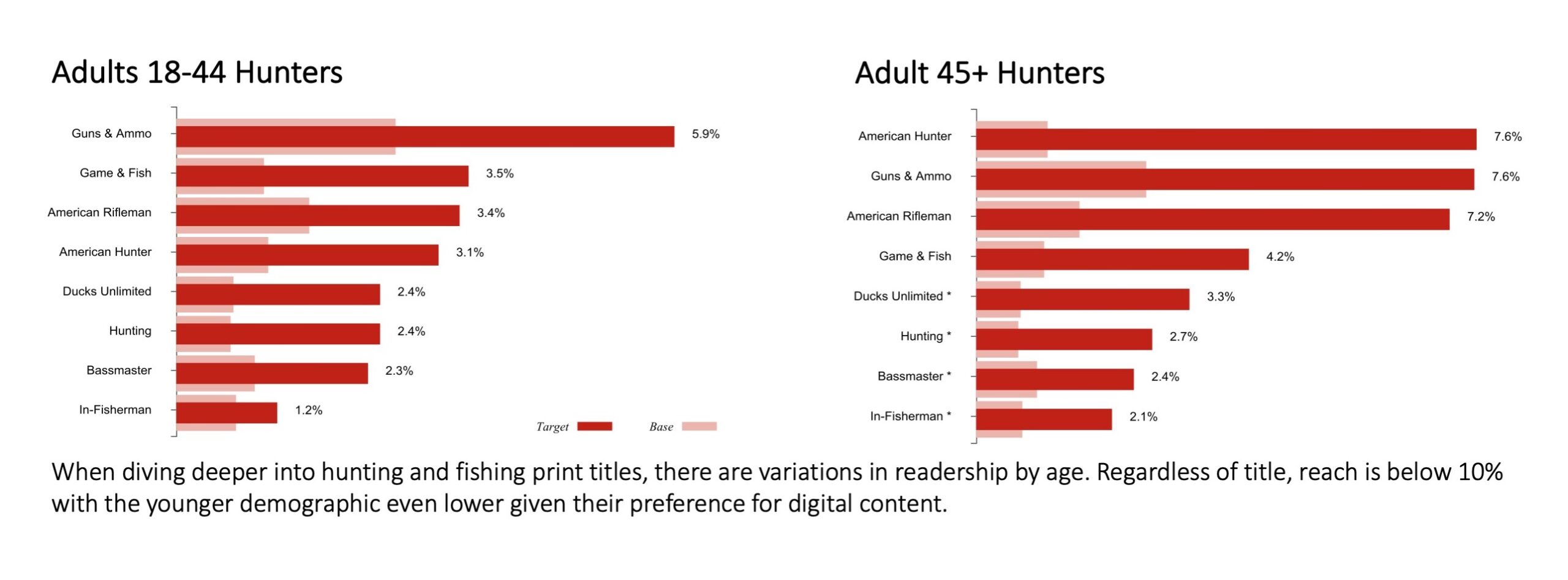 Print media is an area that’s highly fragmented between generations. Older audiences have a higher reach at 80%, are more likely to be heavy magazine users, and typically prefer print content for the large-format hunting ads. In contrast, the younger demo has a reach of 73%, over-indexes as medium magazine users, and prefer digital content. This means it will be more difficult to build frequency among the younger audience with print. Also, don’t assume that hunters are only reading hunting publications. While the top fishing/hunting title is Guns & Ammo, it only reaches approximately 7% of all hunters.
Print media is an area that’s highly fragmented between generations. Older audiences have a higher reach at 80%, are more likely to be heavy magazine users, and typically prefer print content for the large-format hunting ads. In contrast, the younger demo has a reach of 73%, over-indexes as medium magazine users, and prefer digital content. This means it will be more difficult to build frequency among the younger audience with print. Also, don’t assume that hunters are only reading hunting publications. While the top fishing/hunting title is Guns & Ammo, it only reaches approximately 7% of all hunters.
“If you’re trying to get new people into the category and go after a younger audience, your mix would skew more digital, whereas if you’re looking to reach that older demographic to buy new products or more products, you might focus more on that traditional space,” says Megan.
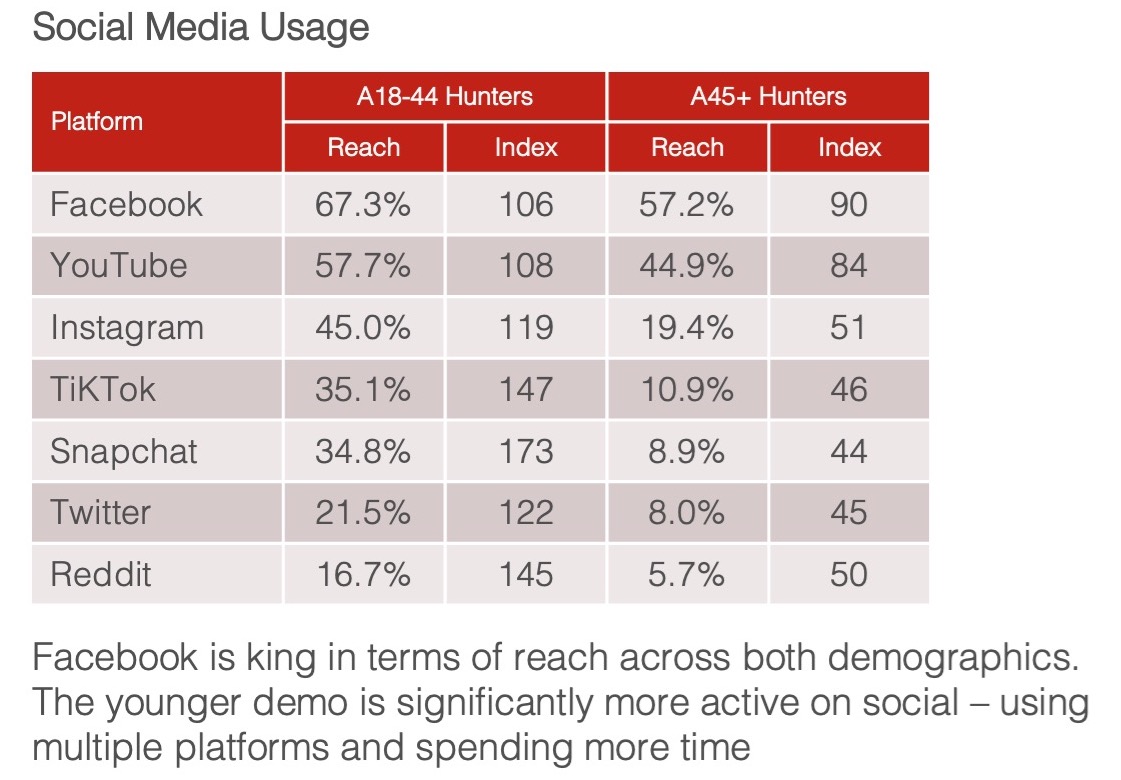
Social media usage is another channel Watauga identified a divergence between the two demographics. While Facebook has the highest reach for all ages, the younger demo is much more likely to use multiple social platforms and spends upwards of five hours a day on the internet. Social channels like YouTube & Reddit have the added benefit of contextual alignment with hunting related content. With the fragmented usage for the younger audience, testing multiple channels is important.
Conclusion
With these insights about the hunting industry, any strategy to reach hunters needs to consider both the older and younger demographics to have the greatest success. Finding the key commonalities between generations like sports and radio will help unite your marketing plan, while recognizing the differences lets you reach more of your audience.

